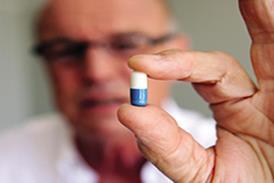Bill Stephens and colleagues discuss the steps that led to the hospital where the NHS was launched merging with another organisation - and its implications.
Park Hospital, Davyhulme, opened in 1929. The modernity of its buildings and its expansive, leafy driveway provided the perfect backdrop for the famous photographs of Aneurin Bevan declaring the NHS open on 5 July 1948. On the 40th anniversary of the NHS the hospital was renamed Trafford General Hospital.
All sides recognised the enormous significance of the change.
Despite our unique history nothing could spare us from the financial realities. Trafford Healthcare Trust was labouring with a historic deficit of £8.3m dating back to 2006-07 and we were below the critical mass required to successfully apply for foundation status.
It was in this context that the trust board made the decision at the end of November 2010 that the only viable option was to seek a merger with another organisation.
While the hospital was destined to move in a new direction, hopefully on a firmer financial footing, every non-clinical member of the trust board would lose their job at the moment of merger. Here we summarise the next 16 months, describing the steps in the process culminating in the merger with Central Manchester University Hospitals Foundation Trust.
Phase 1 – December 2010 to March 2011: preparation
The formal announcement to the staff of the trust and to the public was made at the beginning of December 2010. “The trust board has concluded we are too small to remain viable by ourselves; we have to become part of a larger organisation. It is not realistic to apply for foundation status,” it stated.
With this stark message came the immediate challenge of explaining to all concerned why the decision had been made, the implications of the decision and the steps going forward.
A multifaceted communication strategy was to continue throughout the whole process. Within the trust, regular intranet briefings were posted along with an intranet open forum, paper-based briefings and podcasts by the chief executive.
Face-to-face briefings were held intensively at the start and then at least monthly, giving all staff the opportunity to meet senior members of the acquisition project team.
A series of visits was made to neighbourhood forums and community venues throughout the borough. These were well-attended by the public and were held to allow patients and the public to find out more about why the trust was seeking a merger and how the partner organisation would be selected.
The procurement process was to be run by the trust, rather than the commissioners, and work began on the preparation of a prospectus describing the trust’s assets.
Phase 2 – April 2011 to July 2011: making the decision
The prospectus was published at the beginning of April 2011. Comprehensive financial information and workload figures were made available via a secure virtual data room, making it easier for bidders to develop their proposals.
Bids were invited by 24 June, giving an 11-week window for prospective merger partners to declare. The criteria to be used for evaluation of bids were published. A bid from the private sector was anticipated in case we had to move to open tender but this proved unnecessary and we learned it was our two immediate neighbouring FTs that had submitted bids by the deadline.
A choice had to be made. It was to be a local decision made by the trust board but supported by staff and representatives of the population of Trafford. Four reference groups were established: clinical; staff-side; patient and public; and external stakeholders. They had already played a role in developing the prospectus and deciding the bid criteria. They now held centre stage in evaluating the bids.
Each operated separately and made their eventual recommendation independently and without knowledge of deliberations taking place in the other reference groups. A fifth arm of the evaluation process comprised a financial, technical and legal appraisal.
The decision had to be evidence-based and rooted in a rigorous scoring methodology linked to the evaluation criteria.
A key event took place on 13 July when the senior management of the two bidding FTs made their pitch to the reference groups. Each reference group was charged with making a recommendation to the trust board by 26 July and it is likely that the tone set at that meeting had a significant effect on the outcome. Inevitably there were structural similarities in the two bids and this allowed scope for emotive reflections such as: who can we best work with? Who seems to value and respect us as an organisation? Who do we trust to take us over?
The announcement was made that each of the reference groups, and also the financial/technical/legal appraisal, had come to the same conclusion and recommended acceptance of the bid from Central Manchester University Hospitals Foundation Trust. Now that all parties had come to the same decision on our future, we were all duty-bound to make it work.
Phase 3 – August 2011 to December 2011: external approval
Once the preferred bidder had been identified, there was a prompt process to agree the heads of terms with all key participants including commissioners and system managers. A due diligence exercise then began and, subsequently, the process of seeking permission from regulators.
The first green light was showing by early September and this was the signal for the senior management of the acquiring trust to visit, address the staff and field questions in open forum. The importance of these visits to the Trafford staff cannot be overstated. The opportunity to put faces to names and to hear at first hand what our prospective acquiring FT intended was crucial in galvanising the wider workforce towards making the merger a success.
A full turn-out by the Central Manchester University Hospitals Foundation Trust senior management at these forums sent a message that we were being treated with respect and considered a valuable partner. The promise to retain Trafford’s distinct identity within the bigger organisation boosted morale at a challenging time and was warmly received.
Phase 4 – January 2012 to March 2012: transition
Being an “as is” merger, there was to be no visible impact on the clinical side, so wards, A&E and service departments would look exactly the same immediately post-merger. Clinical changes were to come later, as a result of service redesign and public consultation.
The shocking change, slowly dawning on people, was the imminent loss of the chief executive, chair, finance director, HR director, medical director, director of nursing, and director of estates and all other non-clinical members of the board. The trust board was in the unenviable situation of still having full responsibility while allowing room for transitional management arrangements to develop. There was a gradual realisation of the implications of a merger and acceptance that the place would feel very different as part of a larger organisation.
To recognise achievement and give thanks for dedication, the trust board held a celebration of service excellence, attended by more than 500 staff from all disciplines, departments and grades. This was considered a suitable ending and at midnight on 31 March 2012 Trafford Healthcare Trust ceased to exist.
This merger was completed with a striking absence of the angst and rancour that so often accompanies realignment within the NHS. The process was run by the trust, with the staff, patients and public having a major role in guiding the trust board’s final decision via the reference groups. The timescale was brisk but not rushed.
All sides recognised the enormous significance of the change coming for this proud and independent trust. Adequate time had to be allowed for staff to understand and respond. Openness of communication channels was the key.
We were fortunate enough to have to make a choice between two highly eligible suitors, either of which would have made an excellent merger partner. However, we could only choose one – and having made the choice the onus is on us to make sure of its success. The local populations expect and deserves no less.
The challenge for 2012-13 is to complete planning and consultation on the shape of clinical services to be delivered from the Trafford site under the umbrella of Central Manchester University Hospitals. Only then will the project truly be complete.
More about the merger
- Announcement of merger – briefing notes;
- Summary of communications strategy;
- The prospectus;
- Bidder instructions;
- The evaluation criteria;
- The South Manchester bid;
- The Central Manchester bid;
- Composition of the reference groups;
- Announcement of the decision on preferred bidder;
- Central Manchester University Hospitals Foundation Trust briefing to Trafford staff on transition;
- Transitional management arrangements;
- TUPE – staff consultation paper.
Bill Stephens is a consultant physician and chair of the medical advisory committee at Trafford General Hospital. Jessica Bradshaw is former director of human resources, Trafford Healthcare Trust and acquisition project director; Emer Scott isformer head of communications, Trafford Healthcare Trust; Stephen Gardner is Trafford Healthcare Trust acquisitionproject director, Central Manchester University Hospitals Foundation Trust; and Margaret Roberts is staffside chair, Trafford Hospitals.
Downloads
Announcement of merger - briefing notes
WordSummary of communications strategy
WordThe prospectus
PDFBidder instructions
PDFEvaluation criteria
WordThe South Manchester bid
PDFThe Central Manchester bid
PDFComposition of the reference groups
WordAnnouncement of the decision on preferred bidder
WordCentral Manchester briefing to Trafford staff on transition
WordTransitional management arrangements
WordTUPE - staff consultation paper
PDF
























1 Readers' comment